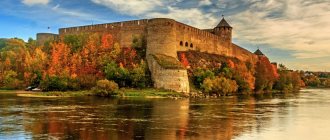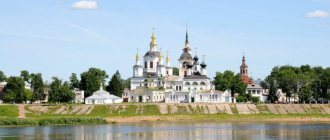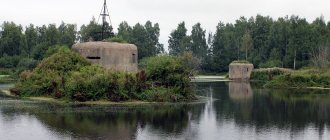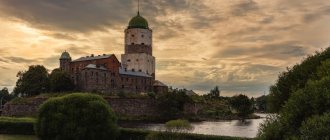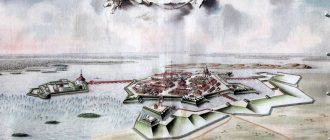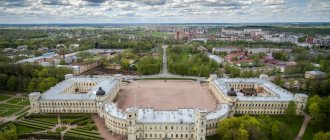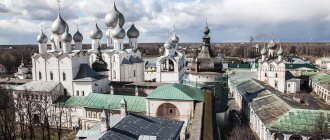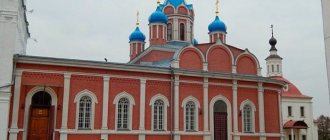In 1704, Peter the Great, by a special decree, ordered the founding of a city near the Nikolo-Medvedsky Monastery. It was supposed to become a garrison for the troops guarding the canal and the shipyard at the mouth of the Volkhov. About two thousand workers from the Russian North were brought to the construction site, and soon army infantry regiments were stationed.
Most of the residents of now Staraya Ladoga moved to Novaya Ladoga in accordance with the royal decree. This is how the city arose, which today has about 9 thousand inhabitants.
Nikolo-Medvedsky Monastery
Address: st. Karl Marx, 49 Phone: (81363) 3-01-19 Website: www.pravladoga.ru
The monastery was built in the 14th century on the Medvedets Peninsula. It was a resting place for travelers traveling with goods to Scandinavia and Constantinople along the rivers and Lake Ladoga.
Since the monastery was located practically on the border of Rus', it was repeatedly attacked. The Livonian knights destroyed the monastery almost to the ground. Later the shrine was rebuilt, but in the 18th century the monastery was closed by Peter the Great. The Tsar granted the lands of the monastery to Alexander Menshikov.
Today, an earthen rampart, part of a wall, a forged lattice and a cemetery have been preserved here. There are two churches on the territory of the monastery: the Church of St. John the Evangelist and St. Nicholas Cathedral.
The Cathedral of the Nativity of the Blessed Virgin Mary, after construction was completed in the 18th century, was illuminated as the Church of St. John the Evangelist . A hundred years later, a chapel in honor of the Nativity of the Virgin Mary was added to the monastery, and the church received her name.
Currently, services at the monastery are held on weekends and holidays. The rest of the time the church is closed.
St. Nicholas Cathedral, or St. Nicholas Cathedral , is a four-altar church built of stone. Until 1704 it was the cathedral of the Nikolo-Medvedsky Monastery. It closed and reopened several times. The temple is currently undergoing reconstruction.
Staraya Ladoga Fortress
One of the main attractions of Staraya Ladoga is the Staraya Ladoga Fortress, which was founded at the end of the 9th century.
The fortress was originally built from wood, but this seemed ineffective and so the fortress was rebuilt from stone for greater hardness. It was very important because it protected the entire waterway. Today it houses a museum that houses many different exhibits.
Museum of Local Lore
Address: st. Pionerskaya 16 Phone: (81363) 3-05-98 Website: www.museum.ru Opening hours: 9.00-18.00, Mon – day off Cost: adults – 80 rubles, children and students – 30 rubles
A museum telling the history of the region in Novaya Ladoga was created relatively recently, in 1987. The modern museum occupies the two-story mansion of the merchant I. Timofeev.
There is an exhibition dedicated to the history of the city. Its exhibits tell about the construction of canals, about A. Suvorov’s stay here, about the events of 1917, about the Road of Life for besieged Leningrad, about the history of the Ladoga military flotilla.
In the merchant and interior halls, a detailed reconstruction of the ladies' drawing room, you can see urban interiors typical of the mid-19th century. The ethnographic hall displays household items from the Southern Ladoga region: spinning wheels, tablecloths, dishes, an original collection of irons, and fishing gear.
My impressions of Novaya Ladoga
Novaya Ladoga made an ambivalent impression on me. On the one hand, there is a beautifully planned city, a wide main street, the majestic Volkhov, canals, and the vast Lake Ladoga. But many buildings are dilapidated and require repairs. I think if it gets cleaned up it will become a popular tourist spot.
Wooden house in Novaya Ladoga
Entrance in a wooden house
Volkhov in Novaya Ladoga
Ships on the Volkhov in Novaya Ladoga
Mouth of the Volkhov
Ships near Volkhov
Arrow at the mouth of the Volkhov
Volkhov
Wooden house in Novaya Ladoga
Houses in Ladoga region
© Website “On the Roads of the Middle Way”, 2009-2021. Copying and reprinting of any materials and photographs from the site anashina.com in electronic publications and printed publications is prohibited.
Monument to the Ladoga Military Flotilla and a memorial in honor of the Road of Life
Address: pl. Kirov
In 1941, Novaya Ladoga became a front-line city. The Ladoga military flotilla was stationed here. In winter, cars with food began to be sent from the city across the ice of Lake Ladoga to besieged Leningrad, and survivors of the siege were brought back.
In 1982, minesweeper ship No. 100 was installed on the square. This Finnish ship was captured by ships of the Ladoga military flotilla and re-equipped into a minesweeper. In 1942, it took part in the battle for Suho Island. Now visitors can climb onto the captain's bridge and examine the ship's combat guns.
Together with the tugboat "Kharkov", ship No. 100 is also included in the Road of Life memorial. Information about the events of those days is posted on memorial plaques.
Caves
See prices for hotels in Ladoga on Booking.com=>>
Staraya Ladoga is famous not only for its Architecture; there is something else, but no less interesting. These are caves. In old Ladoga there are as many as 2 dungeons. As is right, tourists who come to Staraya Ladoga always specially visit this place. These dungeons were created artificially. White sandstone was mined here, which was later used for glass production. Then the caves began to be used to study fossilized animals. There is one amazing place here, in one of the places at the farthest point of the cave the temperature is always 6 degrees Celsius. One of the dungeons has an underground lake with a depth of 0.5 meters, which never dries up.
Attention. To avoid getting lost, visit the cave only with experienced guides.
Church of Clement of Rome and Peter of Alexandria
Address: Karl Marx, 41
In the 18th century, a one-domed church was erected; in the 19th century, under the leadership of architect K. Fortunatov, a bell tower with a spire was added, which significantly changed the appearance of the temple. The church was closed in the early thirties. Now it is empty.
Links[edit]
Notes[edit]
- ^ abcdef Provincial Law No. 32-oz.
- ^ abcd Encyclopedia of Russian Cities
. Moscow: Great Russian Encyclopedia. 2003. p. 303. ISBN. 5-7107-7399-9. - ^ a b Federal State Statistics Service (2011). “All-Russian Population Census 2010. Volume 1" [All-Russian Population Census 2010, vol. 1]. All-Russian Population Census 2010 [All-Russian Population Census 2010]
. Federal State Statistics Service. - "26. The size of the permanent population of the Russian Federation by municipalities as of January 1, 2021". Federal State Statistics Service. Retrieved January 23, 2021.
- ^ abcd Law No. 56-oz.
- "On the Calculation of Time". Official Internet portal of legal information
. June 3, 2011. Retrieved January 19, 2021. - Post office. Information and computing center of OASU RPO. ( Post office
).
Search for postal service objects ( postal Search for objects
) (in Russian) - ↑
Federal State Statistics Service of Russia (May 21, 2004).
“The population of Russia, the constituent entities of the Russian Federation as part of federal districts, urban settlements, settlements, settlements is 3 thousand or more people” [Population of Russia, its federal districts, federal districts, districts Urban settlements, rural settlements - administrative centers and rural settlements with a population of over 3,000] (XLS). All-Russian Population Census 2002
. - “All-Union Population Census of 1989. The actual population of the union and autonomous republics, autonomous regions and districts, territories, negative phenomena, urban settlements and rural areasCulture of the Leningrad Region.” Retrieved March 18, 2014.
- ^ abcd “Archival copy” Novoladozhsky district (1917 - February 1923), Volkhovsky district (February 1923 - August 1927) (in Russian). System of classifiers of executive bodies of state power of St. Petersburg. Archived from the original on February 22, 2014. Retrieved March 18, 2014.CS1 maint: archived copy as title (link)
- ^ abcde “Archival copy” Volkhov district (August 1927) (in Russian). System of classifiers of executive bodies of state power of St. Petersburg. Archived from the original on March 17, 2014. Retrieved March 18, 2014.CS1 maint: archived copy as title (link)
- Monuments of history and culture of the peoples of the Russian Federation (in Russian). Ministry of Culture of Russia. Retrieved June 2, 2016.
Birth of a city
Novaya Ladoga became one of these satellite cities. In 1702, not far from Lake Ladoga, or rather near the mouth of the Volkhov River, a new shipyard appeared, where about 2,000 shipwrights were brought, mainly from the North. And already in 1704 (a year after the founding of St. Petersburg), here, by decree of Peter the Great, a city was founded, which received the name Novaya Ladoga, while the ancient Russian settlement of Ladoga, located 15 km away, from that moment became Staraya Ladoga. In memory of this, from grateful descendants, on the eve of the celebration of the 300th anniversary of Novaya Ladoga, a bust of the founder was erected in a small cozy square at the intersection of Karl Marx Avenue and Old Canal Street, and a lot of banners were hung in the city and information stands with the image of Peter were installed in the city.
Novaya Ladoga
However, not only the role of supplier of ships for the Russian fleet was destined for the young city. By order of Peter (that is, by force), many people from surrounding settlements move here. And very soon they found something to do: in 1719, construction began on a 117 km long canal along the shore of Lake Ladoga, connecting the Volkhov and Neva rivers and later receiving the name Petrovsky Canal.
The fact is that Lake Ladoga is quite complex even for modern shipping, not to mention ships of the 18th century. Local old people have a proverb: “Whoever has not walked around Ladoga does not know how to pray.”
The lake is characterized by a large number of depth changes - “cans”, when great depth abruptly turns into a shallow. Lake Ladoga is also known for its “mood swings” and it is absolutely normal for it when a calm with serenely rolling “lambs” turns into a hurricane wind with waves several meters high within 10-15 minutes. Actually, the word “Ladoga” itself in the ancient Slavic and ancient Finnish languages meant “wave”. To improve the safety of ships traveling along the waterways, which in ancient times were called “from the Varangians to the Greeks” and, accordingly, to improve the terms of trade, the Petrovsky Canal was dug, which cost a gigantic effort of a huge number of people.
Later, in 1861-1866, almost parallel to Petrovsky, the New Canal was dug (it was also called Ekaterininsky, after the revolution - Proletarsky) between Novaya Ladoga and Shlisselburg (a suburb of St. Petersburg), taking into account the radically changed characteristics of ships with a length of 110 km. Also in Novaya Ladoga you can see the Petrovsky Locks, or rather what remains of them. This ancient hydrological structure, alas, is partially destroyed.
The charming layout of the city, in which, along with the streets, canals clearly outlined with geometric regularity appear on an equal footing, immediately brings to mind a comparison with Venice.
